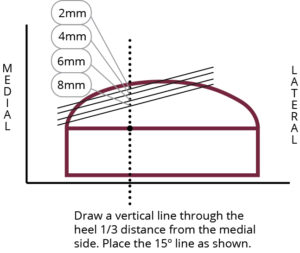You may call it a Kirby Skive or a medial heel skive. This interesting accommodation is constructed by removing small amounts of the medial portion of the plantar heel of the positive cast of the foot to create a varus wedging effect within the heel cup of the custom orthotic. Extrinsic rearfoot posting is required to maintain rear foot stability. Intrinsic heel pads cannot be used with medial skives.
The Kirby Skive allows for increased ground reactive forces through the custom orthotic on the medial plantar side of the calcaneus and will thereby decrease the eversion of the heel.
The size of the medial heel skive is determined in millimeter increments. The greater the amount, the greater the varus wedging in the heel cup. This provides a greater force exerted to cause supinatory movement.
Kirby Skives can improve pronation control on flexible flat feet, PTTD (Stage I and Stage II) and other types of excessively pronated feet.
Medial skives are not recommended for patients with lateral ankle instability, lateral heel pain and thin heel fat pads.
The medial skive was actually first described by J Martin Carlson in his published article
“An effective orthotic design for controlling the unstable subtalar joint” in the Journal of Orthoics and Prosthetics, Vol 33, No 1 in 1979. Carlson uses language and diagrams almost identical to what Kirby published 13 years later. Thus, the term “Kirby Skive” is really not appropriate as it gives credit for an original innovation.
That medial intrinsic heel wedge Martin Carlson demonstrated on plaster (misspelled in his paper as Colson) was doing what I suspect was done for centuries with shoes, with sole and heel wedges. (See Isidore Zamosky’s 1964 article, "Shoe Modifications for Lower Extremity Orthotics.) I’d say Kirby’s take is more refined and deserves the credit. What is referred to as the Carlson modification is the sustentaculum tali modification, often used with pediatric UCBLs.
K is for Kirby Skive
You may call it a Kirby Skive or a medial heel skive. This interesting accommodation is constructed by removing small amounts of the medial portion of the plantar heel of the positive cast of the foot to create a varus wedging effect within the heel cup of the custom orthotic. Extrinsic rearfoot posting is required to maintain rear foot stability. Intrinsic heel pads cannot be used with medial skives.
The Kirby Skive allows for increased ground reactive forces through the custom orthotic on the medial plantar side of the calcaneus and will thereby decrease the eversion of the heel.
The size of the medial heel skive is determined in millimeter increments. The greater the amount, the greater the varus wedging in the heel cup. This provides a greater force exerted to cause supinatory movement.
Kirby Skives can improve pronation control on flexible flat feet, PTTD (Stage I and Stage II) and other types of excessively pronated feet.
Medial skives are not recommended for patients with lateral ankle instability, lateral heel pain and thin heel fat pads.
Have questions about skives? We’re here to answer them.
Leave a reply© SOLO Labs 2017
The medial skive was actually first described by J Martin Carlson in his published article
Reply“An effective orthotic design for controlling the unstable subtalar joint” in the Journal of Orthoics and Prosthetics, Vol 33, No 1 in 1979. Carlson uses language and diagrams almost identical to what Kirby published 13 years later. Thus, the term “Kirby Skive” is really not appropriate as it gives credit for an original innovation.
Thanks for sharing your insight.
Replyagreed
ReplyThat medial intrinsic heel wedge Martin Carlson demonstrated on plaster (misspelled in his paper as Colson) was doing what I suspect was done for centuries with shoes, with sole and heel wedges. (See Isidore Zamosky’s 1964 article, "Shoe Modifications for Lower Extremity Orthotics.) I’d say Kirby’s take is more refined and deserves the credit. What is referred to as the Carlson modification is the sustentaculum tali modification, often used with pediatric UCBLs.
ReplyLeave a reply
Categories
Photostream
Archives